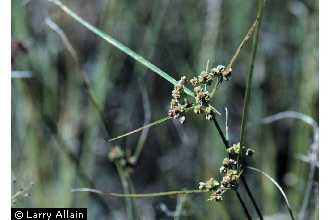Difference between revisions of "Cyperus pseudovegetus"
(→Habitat) |
|||
| Line 35: | Line 35: | ||
===Phenology=== <!--Timing off flowering, fruiting, seed dispersal, and environmental triggers. Cite PanFlora website if appropriate: http://www.gilnelson.com/PanFlora/ --> | ===Phenology=== <!--Timing off flowering, fruiting, seed dispersal, and environmental triggers. Cite PanFlora website if appropriate: http://www.gilnelson.com/PanFlora/ --> | ||
| − | It is known to flower from July to October.<ref name= "Weakley"/> | + | It is known to flower from July to October.<ref name= "Weakley"/> This flowering period is also when fruit is developed.<ref name= "lady bird">[[https://www.wildflower.org/plants/search.php?search_field=&newsearch=true]] Lady Bird Johnson Wildflower Center. Accessed: April 25, 2019</ref> |
<!--===Seed dispersal===--> | <!--===Seed dispersal===--> | ||
<!--===Seed bank and germination===--> | <!--===Seed bank and germination===--> | ||
Revision as of 14:58, 25 April 2019
Common Names: Marsh Flatsedge; Green Flatsedge [1]
| Cyperus pseudovegetus | |
|---|---|

| |
| Photo from USDA NRCS Plants Database. | |
| Scientific classification | |
| Kingdom: | Plantae |
| Division: | Magnoliophyta - Flowering plants |
| Class: | Liliopsida - Moncots |
| Order: | Cyperales |
| Family: | Cyperaceae |
| Genus: | Cyperus |
| Species: | C. pseudovegetus |
| Binomial name | |
| Cyperus pseudovegetus Steud. | |

| |
| Natural range of Cyperus pseudovegetus from USDA NRCS Plants Database. | |
Contents
Taxonomic Notes
Synonyms: C. virens Michaux
Variety: none
Description
C. pseudovegetus is a perennial praminoid of the Cyperaceae family native to North America. [1]
Distribution
C. pseudovegetus is native to the eastern United States, including New Jersey and Massachusetts, west to southern Illinois and south Missouri, south to Florida, and west to Texas and Oklahoma.[2]
Ecology
Habitat
Common habitats for the C. pseudovegetus include marshes, ditches, and other depressions with moist soils, for instance samples have been taken from pine flatwoods, edges of ponds and rivers, and other depressions that consist of moist soils.[2][3] It is also listed as a facultative wetland species, where it commonly occurs in wetlands, but can occasionally be found in non-wetland habitats.[1]
Phenology
It is known to flower from July to October.[2] This flowering period is also when fruit is developed.[4]
Conservation and Management
It is listed as rare by the Indiana Department of Natural Resources, and as endangered by the New Jersey Department of Environmental Protection and Energy.[1]
Cultivation and restoration
Photo Gallery
References and notes
- ↑ 1.0 1.1 1.2 1.3 USDA Plant Database Cite error: Invalid
<ref>tag; name "USDA" defined multiple times with different content - ↑ 2.0 2.1 2.2 Weakley, A. S. (2015). Flora of the Southern and Mid-Atlantic States. Chapel Hill, NC, University of North Carolina Herbarium.
- ↑ URL: http://herbarium.bio.fsu.edu. Last accessed: June 2018. Collectors: Loran C. Anderson, K. Craddock Burks, R. K. Godfrey, R. Kral, P. REdfearn, Sydney Thompson, Culver Gidden, R. THorne, R. Davidson, R. Norris, Cecil Slaughter, William Platt, Richar Carter, SHaron Carter, W. George. States and counties: Florida (Wakulla, Liberty, Nassau, Franklin, Washington, Leon, Jefferson, Gulf, Gadsden, Holmes, Calhoun, Taylor) Georgia (Thomas, Upson, McIntosh, Lowndes, Clinch, Berrian)
- ↑ [[1]] Lady Bird Johnson Wildflower Center. Accessed: April 25, 2019